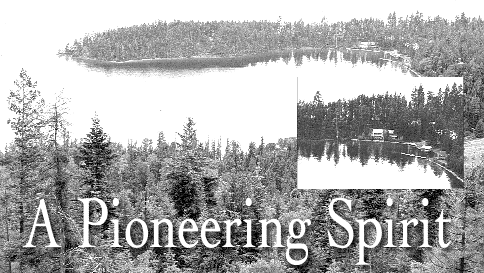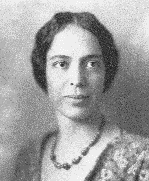 An aerial view of UM's hundred-year-old Flathead Lake Biological Station. Jessie Biermann, Patroness of the Flathead Lake Biological Station
Perhaps it was learning that her father's first wife died after a doctor infected her during the
"I read everything I could find," Jessie Biermann recalled in an oral history published by the University of California at Berkeley. "I talked to every doctor I could find. Then I became terribly interested in why the schools weren't doing something about kids' health. We didn't have any health services in the schools then." Whatever the reason, years before she graduated from high school in Montana in 1918, Biermann knew she wanted to be a doctor. Although she earned her medical degree at Chicago's Rush Medical College in 1926, she didn't spend her life practicing her chosen field of pediatrics. Where Biermann unveiled a pioneering spirit was in the developing field of maternal and child health. Particularly interested in how a child's environment affects development, she advocated a multidisciplinary approach to examining and treating children, taking into account the effects of nutrition, geography, culture and socioeconomic status. "I knew pediatrics, and I had become-for reasons I cannot say-terribly interested in preventive medicine," said Biermann, whose innovations in child health affected medical practices around the world. "It made no sense to me to go on spending enormous sums of money trying to care for a baby who shouldn't have been sick in the first place, if it had just had minimum good care. And that's been my credo." Health Care, Montana-style: Tomato Juice and Cod Liver Oil In 1936 Biermann returned to Montana to direct her home state's maternal and child health program. Funded by the 1935 Social Security Act, the program promoted the health of children and mothers in rural and economically depressed areas. On top of the Great Depression, Montana had suffered from drought since 1929. Food was scarce, so Biermann set up a program to distribute tomato juice and cod liver oil to children. "In order to know what was going on with the children in the state, I did a great deal of traveling," she recalled. "We went out and held demonstration child health clinics in every part of the state. Farmers would bring their kids in, from long distances sometimes, to have them examined."
Biermann also sent out her nurses-she called them "green grassers" because they were greener than anything in eastern Montana-to areas that lacked medical care services. The nurses helped local doctors by providing prenatal care, making home visits to remote areas and distributing commodities. Across the state Biermann and her seven nurses found poverty and hunger, but she admired the families' perseverance. "We made visits to people's homes and found the most marvelous people who were going to stay it out," she said. Biermann also busied herself by investigating specific health problems across Montana. Analyzing state statistics soon after her arrival, she realized the number of infant deaths in one county was nearly as high as the entire state's. She investigated and found a doctor who was contaminating his patients with a skin infection, causing the alarming number of infant deaths. The doctor subsequently was banned from treating obstetric patients. Teaching Public Health It was in California, however, that Biermann began to make significant strides toward improving child and maternal health. Hired in 1942 as the chief of maternal and child health in California's public health department, Biermann instituted hearing tests in the public schools. She also helped children with disabilities by solidifying a permanent source of tax dollars for special education. Yet Biermann's efforts largely were funneled to the Emergency Maternity and Infant Care Program, which provided free medical care to military wives and their children. After five years, Biermann became the first professor of maternal and child health at UC-Berkeley, a position she chose over a Harvard professorship. She taught graduate students-many of them foreigners-to examine public health from many angles, developing a maternal and child health curriculum based on her credo. "[Because] we had made so much progress in physical health of children," she said, "I tended to place a good deal more emphasis than perhaps many departments would on the social and environmental aspects of child health." In 1953 Biermann began what would be her crowning achievement during her twenty years at Berkeley-a study to determine the incidence of fetal mortality in the first twenty-four weeks of pregnancy. The research, based in Kauai, Hawaii, developed into a longitudinal study of the babies who survived. It examined environmental factors such as emotional support, intellectual stimulation, family stability and socioeconomic status. The study resulted in a book, The Children of Kauai: A Longitudinal Study from the Prenatal Period to Age Ten, which revealed that the quality of a child's environment affects mental and social development during the first two years of life. The book became a classic text in early childhood intervention programs in the 1960s. Helping Children Around the World Biermann's research came from and was informed by her world travels. After World War II she traveled to Germany, her father's homeland, to examine the effects of war on children. Two years later she returned to Germany as the maternal and child health consultant with a health team representing the Unitarian Service Committee. In 1955 she joined the United Nations' World Health Organization and traveled to India, where she reduced tetanus in newborns and improved the nutrition of young children by supplementing their diets with vitamin A. "We were trying to see that the people really were aware of how important it was that the children had nutritious food to eat," she said. "We were just then beginning to realize the extent to which serious malnutrition [a]ffects the development of the brain." As chief of WHO's maternal and child health section, Biermann traveled to Singapore and the Philippines, as well as behind the Iron Curtain during the Cold War. She even was evacuated from Egypt in 1956 during the Suez Canal crisis. Returning to the Big Sky Despite her globe-trotting, Biermann was most at home near Flathead Lake in Montana. She was born in Creston, near Kalispell, on April 6, 1900, to Alice Chapman Biermann and Henry Biermann-a buffalo hunter, freighter, homesteader, farmer, brickmaker and butcher. A self-proclaimed tomboy, Biermann was raised to appreciate nature and be self-reliant-she drove her own horse and buggy before she was twelve. And when she wasn't dismantling automobile engines, she took camping trips with her father. She learned how to fish and smoke her catch-hobbies she enjoyed during her retirement on the west shore's Goose Bay, where she spent summers for the last thirty years of her life. "I would rather be there than anyplace in the world," Biermann said about Flathead Lake. "And I just feel-I've always had this same feeling-that this is where I belong." When she returned to build her home on the Flathead in the 1960s, Biermann rekindled her passion for UM's Flathead Lake Biological Station on the east shore's Yellow Bay. It was there she finished her course work for a bachelor's degree in biology from UM in 1921, only three years after graduating from high school. The station was then under the direction of its founder and Biermann's mentor and major adviser, Morton Elrod. "I really was tutored by this great man for weeks on end-using a microscope for the first time, and doing all of these thrilling things," she said of her three years with Elrod. "It was a wonderful experience." Her love of the area, her fond memories of the biological station, and her general interest in the environment-fostered by her close relationship with her father-led Biermann to become an active and staunch supporter of the station. "Basically, I'm interested in the environment and then early on got this concept of the interdependence of everything in life," she said. "It seems as we exploit resources in the natural environment, we're doing harm to ourselves." With the same determination she afforded her life and career, Biermann stepped forward often to ensure the station's-and the environment's-future. Nearly a decade before she passed away, she donated funds to build housing, maintain the station's research vessel, support graduate work, and endow a professorship. Today the Biermann Distinguished Professorship of Ecology and the station's launch, the Jessie B, honor her efforts. "I am humbled and enormously motivated as the Biermann Professor." says Jack Stanford, the station's director. "Without Jessie, the biological station would not be what it is today." Whether it was the children or the environment, Biermann dedicated her life to the preservation of the world's precious resources. "I don't rest until I have done something about something that needs changing," she said at age eighty-six.
Janelle Leader Lamb wrote a history of the Flathead Lake Biological Station titled A Century of Science. Source: Jessie Biermann, Maternal and Child Health in Montana, California, the U.S. Children's Bureau, and WHO, 1926-1967, an oral history conducted in 1986 by Jacqueline Parker, Regional Oral History Office, The Bancroft Library, University of California, Berkeley, 1987. |

